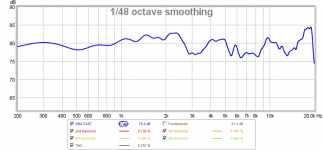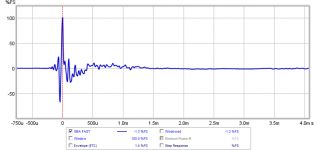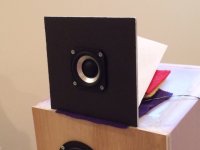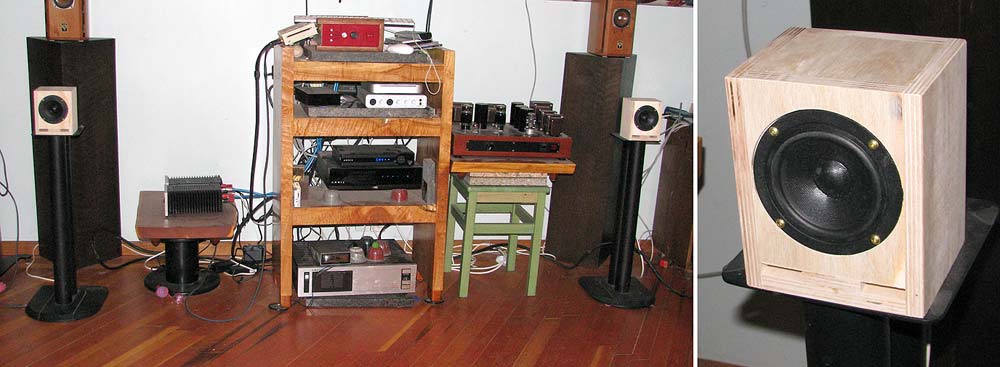I found an independent test done by Voice Coil on the SB65WBAC25-4
http://www.daytonaudio.com/media/resources/ES140Ti-8 Voice Coil Review by Vance - January 2015.pdf
See pages 7 - 11
The CSD is not as clean as the other drivers I am considering, esp at 20kHz and in the 300Hz to 1 kHz area. But, the off-axis frequency response looks promising, 5 dB deviation at 6 KHz, then major drop at 9 kHz, then coming together again at 15 kHz with an 8 dB deviation. Pretty close to the manufacturer's. The reviewer did suggest EQing the upper response. As there is a mid-range valley centered at 600 Hz, I believe that is a good idea.
I like the off axis response, not so sure on the CSD.
Qts 0.54 (Voice Coil)
Qts 0.68, Bl 2.9, Mms 2.4 g (SB Acoustics)
Manufacturer was conservative with Qts, yet I would personally like to set more driving force (BL) to put it in the same bracket as the other drivers.
What do You guys think?
My measurements of this driver have quite a variance from the factory Qts. It measured higher like a TC9FD. The frequency response if fairly smooth, with some peaks but not too bad. This was done in a small Dagger:
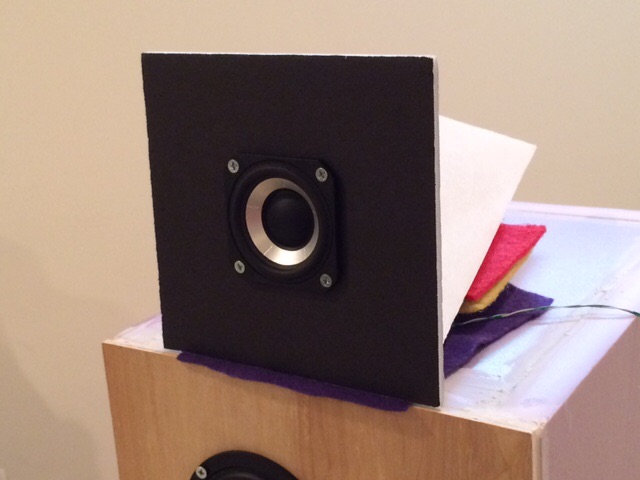
Freq response with 4ms gate at 0.5m:
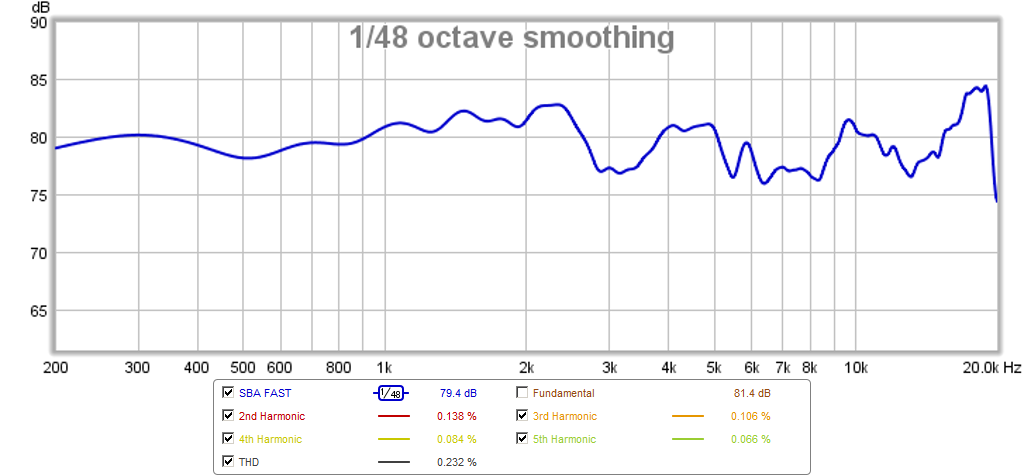
Impulse response:
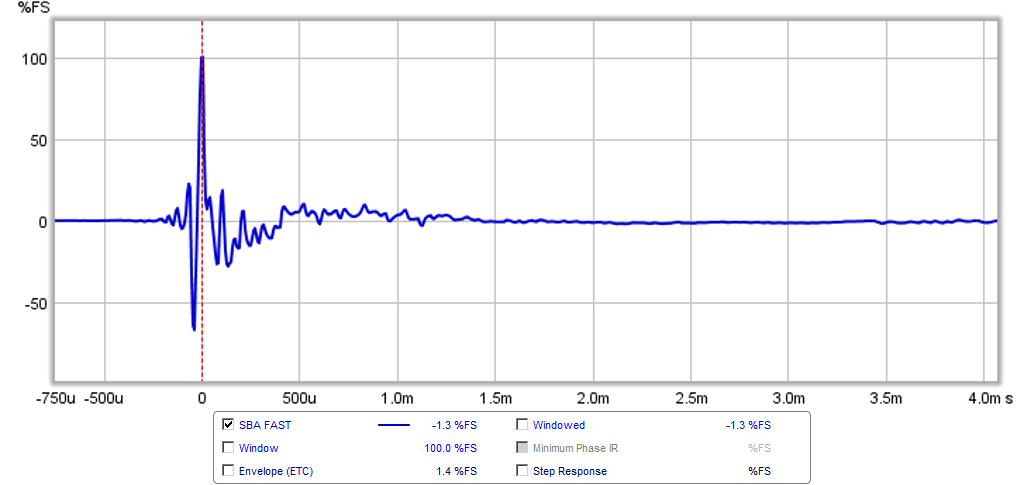
TS parameters:
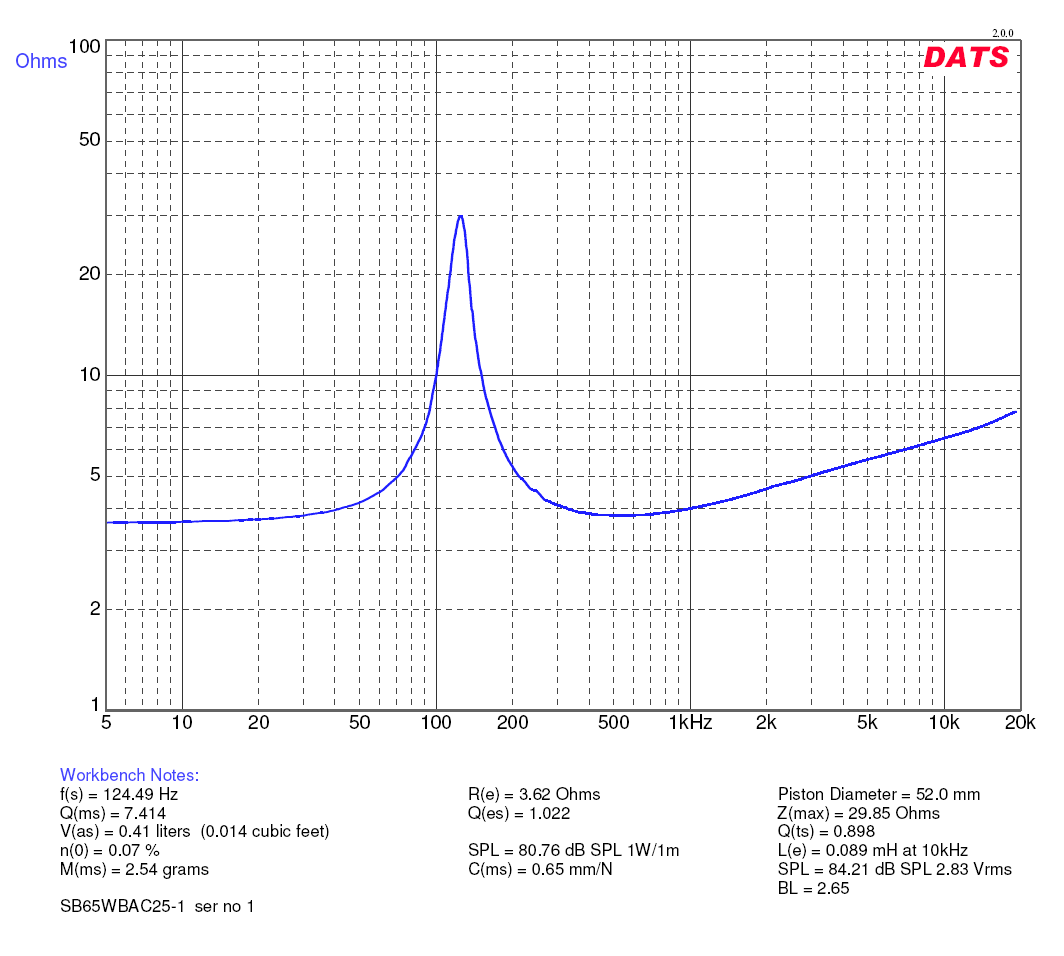
Attachments
Last edited:
Rubber fetish....
I Allen,
I have never tested a polycarbonate surround driver so really cant comment.
My "never rubber" opinion comes from my focus on CSD time domain performance....See attached for an explanation.
Disclaimer: Lots of folks round here (who have not heard my speakers!) say I am wrong on this....Those who have heard my speakers agree with me!
Rubber surrounds are cheap, reliable and are available off the shelf in a thousand sizes and stiffness's.
Cloth surrounds are not as popular because they are much harder to tune correctly and they are not available in anywhere near as many off the shelf sizes.....
OEM ing your surround gets expensive, you have to spend a lot of R&D time balancing Xmax & linear travel Vs voice coil centering and Fs.
Plus the sealing / damping compounds are expensive (if you use the good ones) and have to be very carefully applied by hand as consistency and accuracy are essential.
Quality control of 0.1g per surround damping compound is required with our double roll silk surrounds.
Anything less accurate would affect the BMR counter balancing weights
(they control and define the frequency of the bending modes) on the inside of the flat cone.
The bottom line is if you want your cone to behave like a "good piston" and start and stop accurately, why would anyone use a rubber band for the brakes....???!!!
Hope this helps and all the best
D.
This question is for Derek: You say never rubber, but how about polycarbonate enhanced foam?
I Allen,
I have never tested a polycarbonate surround driver so really cant comment.
My "never rubber" opinion comes from my focus on CSD time domain performance....See attached for an explanation.
Disclaimer: Lots of folks round here (who have not heard my speakers!) say I am wrong on this....Those who have heard my speakers agree with me!
Rubber surrounds are cheap, reliable and are available off the shelf in a thousand sizes and stiffness's.
Cloth surrounds are not as popular because they are much harder to tune correctly and they are not available in anywhere near as many off the shelf sizes.....
OEM ing your surround gets expensive, you have to spend a lot of R&D time balancing Xmax & linear travel Vs voice coil centering and Fs.
Plus the sealing / damping compounds are expensive (if you use the good ones) and have to be very carefully applied by hand as consistency and accuracy are essential.
Quality control of 0.1g per surround damping compound is required with our double roll silk surrounds.
Anything less accurate would affect the BMR counter balancing weights
(they control and define the frequency of the bending modes) on the inside of the flat cone.
The bottom line is if you want your cone to behave like a "good piston" and start and stop accurately, why would anyone use a rubber band for the brakes....???!!!
Hope this helps and all the best
D.
Attachments
Well the brakes are applied by the woven cloth spider often used on rubber surrounds.
I have to admit that the two cloth surround pro audio full range drivers that I have, I like their sound - dynamic, ease of reproduction, they get very loud with less distortion - but a lot of that is the big fat motors and stiff spider suspension.
I have to admit that the two cloth surround pro audio full range drivers that I have, I like their sound - dynamic, ease of reproduction, they get very loud with less distortion - but a lot of that is the big fat motors and stiff spider suspension.
I am curious to know how You are able to draw the conclusion to "bet" on the FF85wKen?
At this point i have not yet directly compated them but have listened to both. That us what i an basing my guess on I initially abandoned the 10F as a FR because it could not do bass on its own.
But today Chris is building a box with the same kind of alignment as the uFonken and we will directly compare -- the box should be good to 130-140 Hz. (the uFonken is larger and reaches about 80 Hz.
dave
(1) Fabric surround....Never rubber!
I think it comes down more to execution.
Foam has a reputation diue to early failure on early foams. Foam is much more long-lived today.
Rubber cab harden. So can the coating on paper or cloth surrounds. This is called Stiff Surround Syndrome.
Fostex FE use cloth. FF use foam, FE Sigma use foam (brilliant surrounds those). Mark Audio use rubber. 10F is rubber.
I have not seen any paper surround FRs that were not vintage.
dave
I have not seen any paper surround FRs that were not vintage.
dave
LCAO?
At this point i have not yet directly compated them but have listened to both. That us what i an basing my guess on I initially abandoned the 10F as a FR because it could not do bass on its own.
But today Chris is building a box with the same kind of alignment as the uFonken and we will directly compare -- the box should be good to 130-140 Hz. (the uFonken is larger and reaches about 80 Hz.
dave
That was certainly the first thing I noticed when briefly auditioning the 10Fs in the little pipe TLs - no bass at all. The little ported boxes are teeny - it'll be interesting to hear the comparison to the FF85WK - should be ready for that later today.
LCAO?
good catch - the FA6 does look interesting -
anyone here heard them yet?
I think deepgroove sold a pair through the swap meet here a little over a year ago
200 - 300 Hz verses 80 Hz
Thanks for clarifying this, I actually figured that maybe the 10F was less favorable in the highs compared to the FF85wk. Naturally, I prefer to use the least amount of EQ and convolution to get an even response, yet if the 10F does produce a smoother high, better off-axis response or deeper soundstage, the EQ is a trade-off I am willing to accept.
I look forward to hearing your impressions, esp in regards to the mid-range and highs. I do hope You have a chance to try them both in your FAst systems. As I a considering using these with a bass line crossed no higher then 300 Hz, I may not need EQ with either of them, so the final choice will come down to the rendering of mid-range and highs, ability to integrate with the bass line, off axis dispersion and 3D sound stage.
It is time to dig into everyone's impressions of using these higher cross-over points. I am talking mainly in the sense of crossing above the THX standard of 80 Hz to 200 -300 Hz. How does this affect the overall smoothness, unity, and sound staging of the overall sound?
With my Avebury system, I sacrifice some bass agility crossing at 80 Hz to the Subs, but I gain more openness in the mid-range freeing the Alpair of the lower bass. I definitely have much less IM distortion. This is a little different scenario then crossing at 200 to 300 Hz, as one does with these smaller full-rangers. Is some of the mid-range depth lost, crossing over to a higher Mms woofer, or is it a matter of execution?
I am asking these questions to everyone who has experienced FAst systems with these smaller full-range drivers.
Thanks,
Allen
...i an basing my guess on I initially abandoned the 10F as a FR because it could not do bass on its own.
Thanks for clarifying this, I actually figured that maybe the 10F was less favorable in the highs compared to the FF85wk. Naturally, I prefer to use the least amount of EQ and convolution to get an even response, yet if the 10F does produce a smoother high, better off-axis response or deeper soundstage, the EQ is a trade-off I am willing to accept.
That was certainly the first thing I noticed when briefly auditioning the 10Fs in the little pipe TLs - no bass at all. The little ported boxes are teeny - it'll be interesting to hear the comparison to the FF85WK - should be ready for that later today.
I look forward to hearing your impressions, esp in regards to the mid-range and highs. I do hope You have a chance to try them both in your FAst systems. As I a considering using these with a bass line crossed no higher then 300 Hz, I may not need EQ with either of them, so the final choice will come down to the rendering of mid-range and highs, ability to integrate with the bass line, off axis dispersion and 3D sound stage.
It is time to dig into everyone's impressions of using these higher cross-over points. I am talking mainly in the sense of crossing above the THX standard of 80 Hz to 200 -300 Hz. How does this affect the overall smoothness, unity, and sound staging of the overall sound?
With my Avebury system, I sacrifice some bass agility crossing at 80 Hz to the Subs, but I gain more openness in the mid-range freeing the Alpair of the lower bass. I definitely have much less IM distortion. This is a little different scenario then crossing at 200 to 300 Hz, as one does with these smaller full-rangers. Is some of the mid-range depth lost, crossing over to a higher Mms woofer, or is it a matter of execution?
I am asking these questions to everyone who has experienced FAst systems with these smaller full-range drivers.
Thanks,
Allen
My measurements of this driver have quite a variance from the factory Qts. It measured higher like a TC9FD. The frequency response if fairly smooth, with some peaks but not too bad.
Thanks for taking time out to measure this X. I am surprised at the higher QTS myself, as the Voice Coil measurements came out lower then factory. I am wondering if there is an inconsistency with these drivers.
The Frequency Response is not bad, actually it is a little better then some of the full-rangers You measured. Same appears to be true with the impulse response also. Naturally, the 10F looks better, but it should for the $$.
What are your thoughts on that ridge in the CSD at 20 kHz? It is beyond what I can hear, but I do know some people that can hear that high and I am wondering if that would bother them.
Ideally, I prefer a lower overall Qts, as I want the control we were discussing earlier, esp in regards to EQing, but I still like the off-axis dispersion of this driver.
Have You had the chance to listen to this driver and compare it to the others?
Thanks for clarifying this, I actually figured that maybe the 10F was less favorable in the highs compared to the FF85wk.
Chris just brought the 10F boxes by. Will hook them up shortly. Just got a new (to me) FireWire DAC and have to check it out 1st (system is definitely better than with the backup USB DAC)
dave
Thanks for everyone's input on this,
I think that sums it up well. It all comes down to how all the parts work together. And there are some parts that will have more influence then others. And I am sure many existing designs can be improved upon with better parts if one is to go through the process outlined by Derek to execute it properly. I wonder how much it would cost to build a "super" driver that used the best proven parts?
I could not read the .doc file, as I do not have MS software for that. I would imagine surrounds are a little more important for BMR's due to their "bending" properties, but I could not read the .doc to find out. I have the basic WordPad software here and advanced older Graphic Arts stuff. I was ready to upgrade but Adobe went Creative Cloud .
.
Either way, I think we have narrowed the driver choices to the "best" options that are available for this project. I may consider "customization" depending on where the adventure goes...
I need to decide whether to include the SB or not. Wish it had a stronger motor and cleaner CSD. I think the Tectonic is the "hopeful" for the off-axis response. Need to let this all fester in my mind a little longer...
Allen
The bottom line is if you want your cone to behave like a "good piston" and start and stop accurately, why would anyone use a rubber band for the brakes....???!!!
Well the brakes are applied by the woven cloth spider often used on rubber surrounds.
I have to admit that the two cloth surround pro audio full range drivers that I have, I like their sound - dynamic, ease of reproduction, they get very loud with less distortion - but a lot of that is the big fat motors and stiff spider suspension.
I think it comes down more to execution.
I think that sums it up well. It all comes down to how all the parts work together. And there are some parts that will have more influence then others. And I am sure many existing designs can be improved upon with better parts if one is to go through the process outlined by Derek to execute it properly. I wonder how much it would cost to build a "super" driver that used the best proven parts?
I could not read the .doc file, as I do not have MS software for that. I would imagine surrounds are a little more important for BMR's due to their "bending" properties, but I could not read the .doc to find out. I have the basic WordPad software here and advanced older Graphic Arts stuff. I was ready to upgrade but Adobe went Creative Cloud
Either way, I think we have narrowed the driver choices to the "best" options that are available for this project. I may consider "customization" depending on where the adventure goes...
I need to decide whether to include the SB or not. Wish it had a stronger motor and cleaner CSD. I think the Tectonic is the "hopeful" for the off-axis response. Need to let this all fester in my mind a little longer...
Allen
Chris just brought the 10F boxes by... Just got a new (to me) FireWire DAC...
A bit of envy here. You will be enjoying audio, I will be starting a 13 hour shift. I look forward to your impressions when I get done.
Allen
My measurements of this driver have quite a variance from the factory Qts. It measured higher like a TC9FD.
Thanks for taking time out to measure this X. I am surprised at the higher QTS myself, as the Voice Coil measurements came out lower then factory. I am wondering if there is an inconsistency with these drivers.
You have to be careful comparing T/S parameters since they are curves not scalars. To expect similar results the kit used to measure them & the weather (temp & pressure in particular) need to be the same of similar. I usually expect the parameters (Qt & Fs) i measure to be higher than factory.
dave
A new adventure...
So the can of worms has been opened, time for me to learn how to measure drivers...
That is a lot of variables. And makes a lot of sense, now that You mention it. I still appreciate X's effort, as it is interesting to see how these drivers perform and compare in his rig. I may need help from all of You figuring out the best way to measure the drivers for my rig.
So needless to say the drivers are more consistent then our listening/measurement environments. Due to where I live, I have to wonder how driver performance changes from the dry winters to the wet summers where outdoor temperatures range from -60 degrees F to 95 degrees F. Granted, my indoor temperature is pretty consistent, but humidity is not. I have never measured pressure.
Given that information, I am wondering if I should learn to measure my drivers to build the cabinets for my environment. Thankfully, I will be building sealed enclosures, maybe Aperiodic if it is worth the effort.
I will need to do some research on how humidity, pressure, etc affects overall Q.
So if the Q changes based on environment, do I optimize the cabinets for the highest possible Q or the average?
And dare I ask this, what kind of equipment do I need to measure the T/S specs of these drivers in my environment? Would a Dayton DATS work IF I was to set everything up right? Bear in mind, this is mainly to optimize my cabinet alignment to my environment.
I can see the heated discussions starting already!
So the can of worms has been opened, time for me to learn how to measure drivers...
To expect similar results the kit used to measure them & the weather (temp & pressure in particular) need to be the same of similar.
That is a lot of variables. And makes a lot of sense, now that You mention it. I still appreciate X's effort, as it is interesting to see how these drivers perform and compare in his rig. I may need help from all of You figuring out the best way to measure the drivers for my rig.
So needless to say the drivers are more consistent then our listening/measurement environments. Due to where I live, I have to wonder how driver performance changes from the dry winters to the wet summers where outdoor temperatures range from -60 degrees F to 95 degrees F. Granted, my indoor temperature is pretty consistent, but humidity is not. I have never measured pressure.
Given that information, I am wondering if I should learn to measure my drivers to build the cabinets for my environment. Thankfully, I will be building sealed enclosures, maybe Aperiodic if it is worth the effort.
I will need to do some research on how humidity, pressure, etc affects overall Q.
So if the Q changes based on environment, do I optimize the cabinets for the highest possible Q or the average?
And dare I ask this, what kind of equipment do I need to measure the T/S specs of these drivers in my environment? Would a Dayton DATS work IF I was to set everything up right? Bear in mind, this is mainly to optimize my cabinet alignment to my environment.
I can see the heated discussions starting already!
All part of the journey....
Hi Allen,
This is where it starts to get interesting ( and expensive....) buying good test and measuring equipment is as important as good woodworking / soldering / finishing / spraying equipment....All part of that "yellow brick road" to DIY satisfaction...!!
Wesayso...Sorry, forgot to package up that driver....Hectic week, will get to it soon!
Cheers
D.
Hi Allen,
This is where it starts to get interesting ( and expensive....) buying good test and measuring equipment is as important as good woodworking / soldering / finishing / spraying equipment....All part of that "yellow brick road" to DIY satisfaction...!!
Wesayso...Sorry, forgot to package up that driver....Hectic week, will get to it soon!
Cheers
D.
But today Chris is building a box with the same kind of alignment as the uFonken and we will directly compare --
Dave, what is a 'Fonken? I have seen pictures of these cabinets, and I know they are one of your designs.
I am not asking You to give away your design secrets, I am curious to know what the vents on the cabinets do. Does it extend the bass like a ported alignment? Or can this be seen as more of a "leaky" enclosure? Apart from the bass, does this cabinet alignment affect the mid-range performance of the driver?
How did the FireWire DAC sound?
Allen
I may need help from all of You figuring out the best way to measure the drivers for my rig.
Short of buying one of the big-buck professional packages, your best bet is WooferTester 2 from Smith & Larson. I tired quite a few others (less expensive) before settling on this.
dave
Given that information, I am wondering if I should learn to measure my drivers to build the cabinets for my environment. Thankfully, I will be building sealed enclosures, maybe Aperiodic if it is worth the effort.
I measure drivers to match pairs. To design boxes i use the factory numbers, that tends to yield better results.
A sealed box will likely net you more bass and EQ is less problematic. And aperiodic box is used to kill as much reflection as possible from the mid-tweeter. We use aperiodic midTLs in many of our FASTs
Would a Dayton DATS work IF I was to set everything up right?
To my mind you might as well just use the money to take your wife out to dinner.
dave
- Status
- This old topic is closed. If you want to reopen this topic, contact a moderator using the "Report Post" button.
- Home
- Loudspeakers
- Full Range
- All Aspiring Full-Range Array project
